Birds Love Berries: Fruiting Shrubs to Attract More Birds
Looking to attract more birds to the garden? Start by planting these easy-to-grow, fruiting shrubs.
As cold weather settles in, fruiting shrubs offer birds a vital food source. Berries provide a high-energy food to fuel both migrating species and those that settle down for the winter. Even many birds that eat insects all summer long, like bluebirds, turn to berries late in the season. Give winter birds a hand and boost backyard visitors by planting fruiting shrubs in the landscape.
Fruiting Shrubs for Migrating Birds
Birds need extra food to fuel their long flights in autumn. In southern states, many migrating birds are still passing through into the early winter months. Plants that fruit in late summer and early autumn are ideal for fueling migrations.
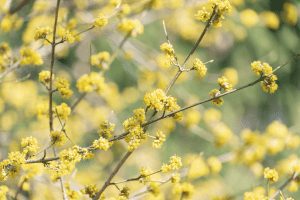
Spicebush, Lindera benzoin, produces an abundance of nutritious berries packed with protein and fat. Many birds feast on spicebush fruits, including American robin, northern mockingbird, red-eyed vireo, wood thrush, and great crested flycatcher.
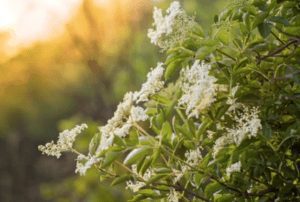
Common Elderberry, Sambucus nigra, also fruits in late summer, producing fruits rich in carbohydrates and protein. Look for hermit thrush, gray catbird, and rose-breasted grosbeak feeding on the berries, among many other bird species.
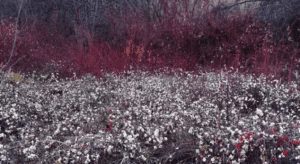
Red-osier Dogwood, Cornus sericea, produces white berries with a high fat content that provide an important food source to migratory birds. Over ninety species, from bluebirds to crows, include red-osier dogwood berries in their diets.
Fruiting Shrubs for Winter Food
Some birds skip migration all together, while many more spend winter in the southern states. These birds need a steady supply of food. While many visit our feeders, others stick to nature’s buffet. The species below are all native to the United States. You can find many similar ornamental varieties are not native to the United States, but it is worthwhile to search out the natives, which flower and fruit in-sync with the needs of native birds.
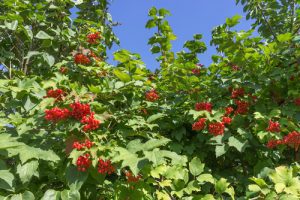
Arrowwood viburnum, Viburnum dentatum, is a gorgeous native viburnum producing blue berries that are adored by American robin, cedar waxwing, northern mockingbird, eastern bluebird, and gray catbird. The fruits have a high fat and protein content, making them an ideal food for overwintering birds.
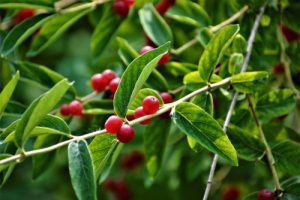
Hollies are another shrub beloved for winter berries. Winterberry, Ilex verticillata, is a northeastern native grown through the eastern states. Eastern bluebirds, American robins, cedar waxwings, and woodpeckers eat the berries, often late in the season.
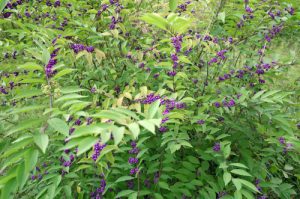
American beautyberry, Callicarpa americana, produces stunning purple fruit beloved by birds and gardeners alike. Plant this shrub where you can watch for black-throated blue warbler, catbird, wood thrush, northern mockingbird, American robin, and northern bobwhite feeding on the berries.
Maintaining an abundance and diversity of fruiting trees and shrubs is a great way to not only attract songbirds to your landscape, but also assist them on their long southward journey. Many birds will also visit suet and seed feeders in winter, so keep those stocked as well. Providing a source of unfrozen water is another way to draw winter birds to the garden.
You must be logged in to post a comment.